|
BULB LOG 16 20th April 2005
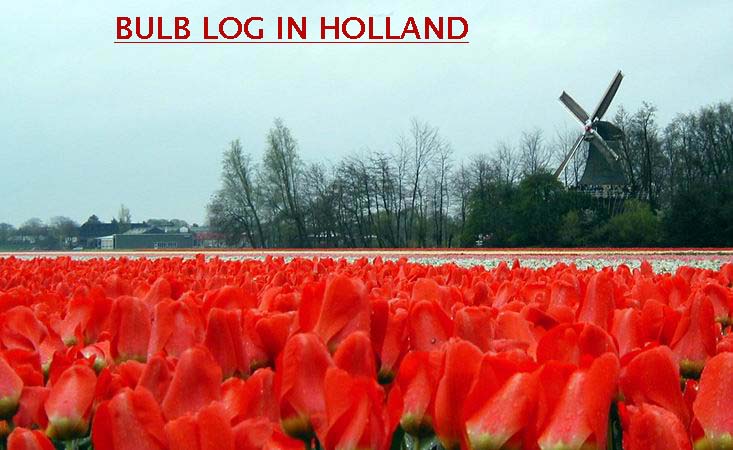
Bulb log in Holland Title
What a wonderful time I had in Holland at the Dutch International Conference. It was great to meet many of you in person there. Thank you for all your kind comments and your support of the bulb log, it is hard work to keep it going every week but it is all made worth while when so many people can share, enjoy and learn from my experiences. My lecture was well received even though I was telling the Dutch how to grow bulbs. They grow on a different level to me; for them quantity is everything, they are bulb farmers, and I am even more aware how big a business it is and how seriously they take it. I was very impressed with the work being carried out at the Centre for improvement of ornamental plants at Hobaho, where they are breeding for disease resistance, among other things.
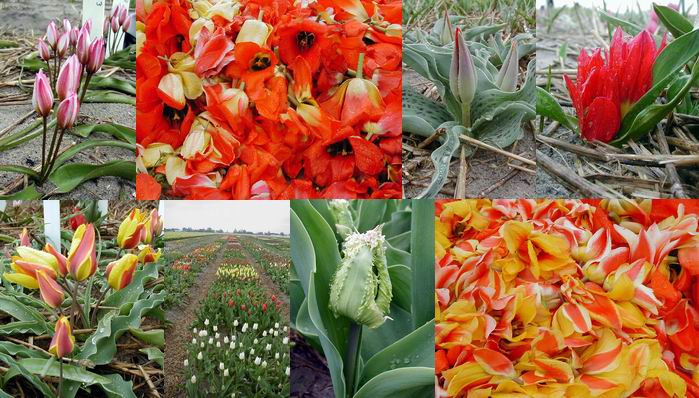
Colours of the tulip
I have made up a montage to give you a flavour of the tulip fields at Hobaho I was especially interested in the dwarf species such as T. cretica and T. kurdica. The piles of removed flower heads were explosions of colour concentrating the effect of the acres of bulbs into a heap. I am posting more pictures from my trip in the general forum, if you want to see more you should go there now - well after you have finished reading the log!
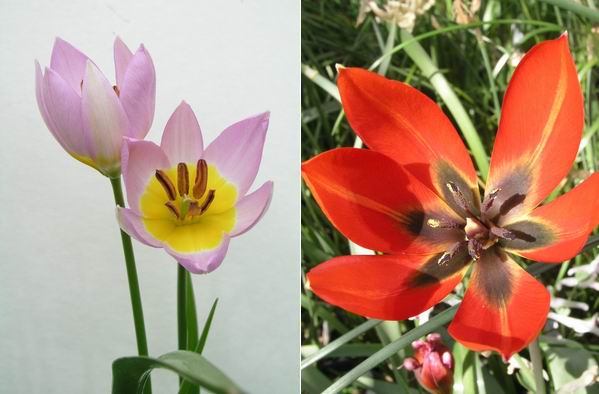
Tulipa saxatilis and bithynica
I do grow a few tulips and I will be looking out to add cretica and kurdica to our collection soon. Above on the left you can see Tulipa saxatilis and T.bithynica is on the right, not quite on the same scale of the above pictures but it is what we have room for.
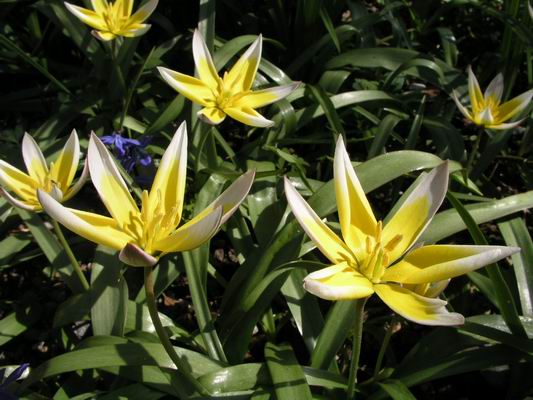
Tulipa tarda
One of the best Tulips for our garden is Tulipa tarda, it has steadly increased over many years and we now have some large patches of its sweetly scented flowers open at the moment. We lift and split them every three to five years when they get a bit congested.
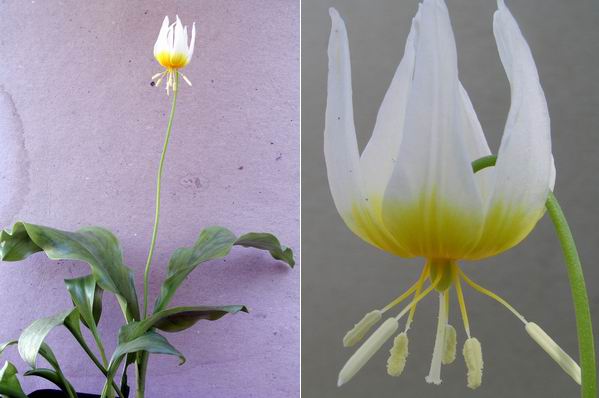
Erythronium taylori plant
Tulips are very closely related to Erythroniums and this is the very first time we have flowered Erythronium taylori. It is a recently described species discovered in 1996 by Dean Taylor at the Stanislaus National Forrest in the Tuolumne River Basin of the central Sierra Nevada, California. This is the only known population and the park staff are managing the habitat to help conserve this plant. It is thought to be closely related to E. pusaterii and also shares some of the characteristics of E. tuolumnense
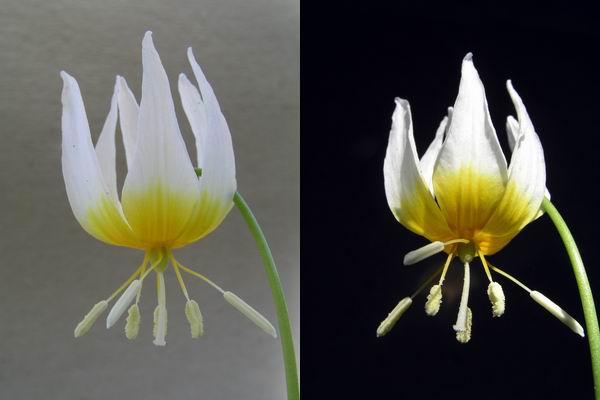
Erythronium taylori
Above are two more pictures to show you the flower, with white petals, a deep yellow centre, slender style and spreading anthers - the leaves are slighty patterned with a wavy edge. It has a strong sweet scent. I hope it will prove to be as good an increaser as tuolumnense.
This is the peak time for erythronium flowers here in Aberdeen with more opening every day. Despite the damage the storms of ten days ago did to them they are looking wonderfull, however I will resist the temptation to show you more this week as I want to show a few more Frits - next week it will be erythroniums.
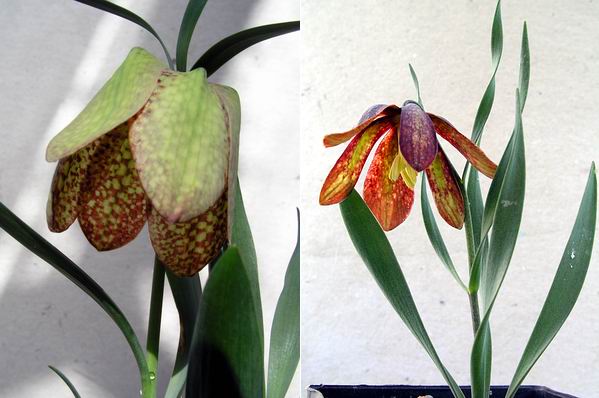
Fritillaria tubiformis and epirotica
Here are few frits, sown as seed in September, 2001 which are flowering for the first time this spring. Fritillaria tubiformis (left) grown from seed from our own plants, has very large dusky yellow flowers on relatively short stems. The original parent plants were raised from wild collected seed and they seem to fall somewhere between the normal purple tubiformis and the yellow sub species moggridgei and this seedling has the same appearance. On the right, with characteristic twisted leaves, is the small Greek Fritillaria epirotica, this form has rather narrow petals, we have other forms that have a fuller flowers with over lapping petals that do not have so obviously twisted leaves.
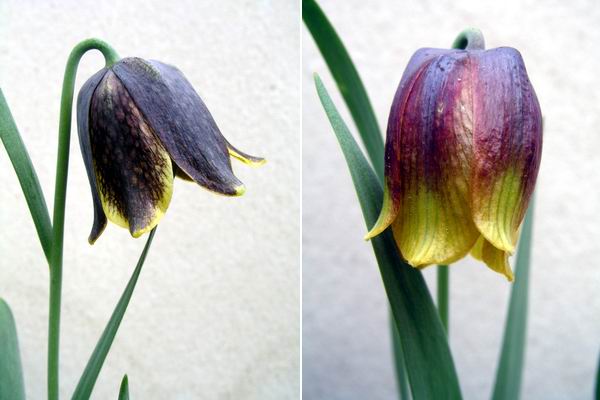
Fritillaria argolica and michailovskyi
There are several frits that have a brown/ yellow colour combination perhaps the best known and certainly the most widely available form ( thanks to the Dutch bulb growers) is Fritillaria michailovskyi on the right. This is not the Dutch form but one of our own raising that we call the 'dwarf form' it is always shorter than other forms we grow and the seedlings from it retain that feature. Less common in cultivation is Fritillaria argolica, (left) another species from Greece. It is quite variable, the colour of the flowers vary from yellow with brown, to brown with yellow, as seen above. Many believe that F. argolica is a species evolved from a naturally occurring hybridisation between F. graeca and Fritillaria rhodokanakis, which is the next picture I am going to show you.
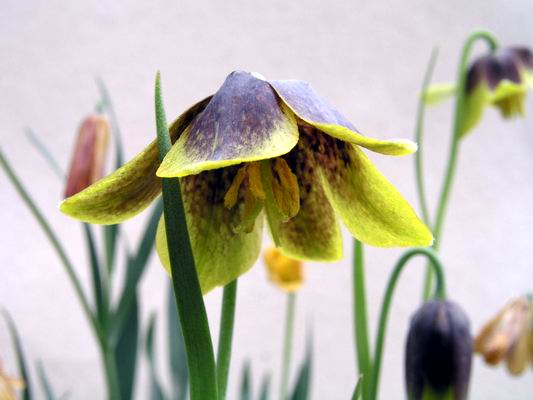
Fritillaria rhodokanakis
Fritillaria rhodokanakis mostly grows on some of the Greek islands but it does also occur on the mainland and that is where it has come into contact with F. graeca. This is how speciation often works; where two species hybridise and produce a fertile off spring, whose own seedlings are consistent, then that is a new species. In the wild this process requires that the two species come close enough to be cross pollinated and can take thousands of years. When we bring so many frits together in a garden we also get hybrids some of which are fertile and produce regular looking off spring but these cannot be described as species and have to be given a cultivar name to take into account the interference of humans in the process.
One of the questions I am constantly asked is when to stop watering the frits? When they are in flower, as in the above pictures, I do reduce the amount of watering directly into the pots. The plants have finished the rapid growth phase of having to build stems, leaves and flowers and are now building the bulb for next year and the seed, if they have been successfully fertilised. It will depend on the temperature in your glasshouse how often you need to water. The best signs are the leaves, as soon as they start to show any signs of drooping at the tip, it is time to water the pot. If the plant has not set seed you will need to reduce the direct watering as the leaves start to yellow - just water the plunge, that will provide the plant with sufficient moisture. As the plant dies back the moisture and nutrients from the stem and leaves are drawn back into the bulb which is now growing rapidly to complete its growth cycle before the summer dormancy. If your plant is setting seed it will continue to grow on for
a further 4 to 6 weeks, then follow the same procedure.
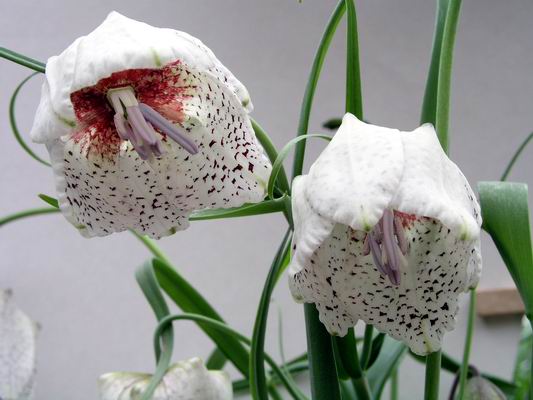
Fritillaria tortifolia
If you are growing the Chinese frits such as Fritillaria tortifolia then you do not dry them out completely. Reduce the watering as described above but do not let them dry out completely as they can start to produce new roots before the growth has died back. These are the first frits I repot , I do this as soon as their growth dies back and give them an occasional watering through the summer so that they are never completely arid.
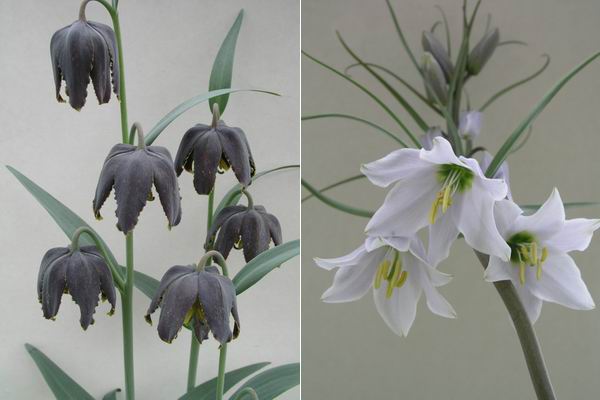
Fritillaria affinis tristulis and yuminensis
Two contrasting frits are, from North America, the reptilian looking Fritillaria affinis tristulis(left) with its fascinating dark glaucus flowers and the graceful, delicate coloured and sweetly scented F. yuminensis(right) from China.
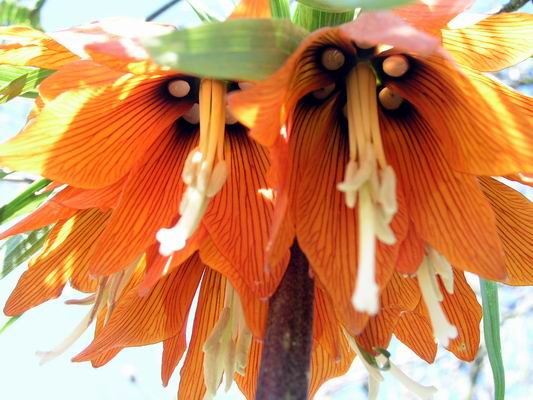
Fritillaria imperialis
Finally for this week an unusual view looking into the wonderful flowers of Fritillaria imperialis to show the white, eye-like nectories that drip a deliciously sweet tasting liquid to attract pollinators to the flowers. It is this that has given rise to the ancient myth that the plant continually weeps. I saw some very good stands of Fritillaria imperialis growing at some of the Dutch nurseries that we visited.
^ back to the top ^
|

